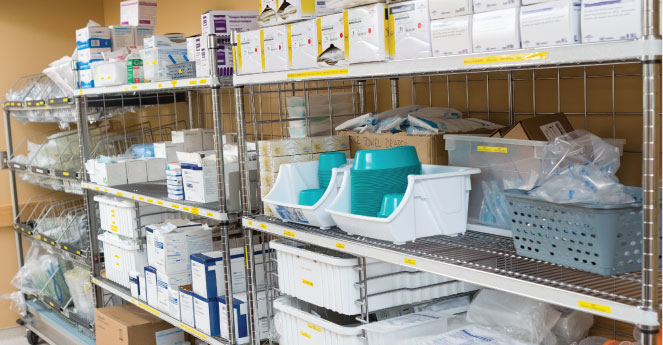In a past article, President and CEO of Terso Solutions, Joe Pleshek discussed if consignment inventory could be seen as a blessing or a curse to suppliers. He concluded that the stark reality facing medical device manufacturers is the necessity to embrace the consignment inventory management model, as more of their customers experience the benefits, such as having to stock less inventory and being able to free up working capital at facilities.
As consignment inventory is becoming more commonplace and the demands of providing such a model are increasing, what can you as a medical device manufacturer do to ensure that you are also reaping the rewards of consignment inventory management, such as increased market share?
Consignment inventory management poses many challenges:
- Investing in large quantities of various products when not all of them will sell
- Customers not having the motivation to use products because there is minimal risk to them
- Overstocking or understocking across locations. Sometimes field representatives will pull inventory from one location and move it to another location, which can cause tension between supplier and customer
However, the model can prove to be extremely beneficial to suppliers and healthcare providers alike.
We’ll take you through three of the biggest considerations to prioritize as you begin looking to branch into consignment inventory management.
1. VISIBILITY
Visibility of inventory is essential in any type of inventory management model, but especially so in a consignment model where a lot is at stake for suppliers. Unfortunately, not all visibility is created equal. Manual efforts to maintain consigned stock is tedious to say the least. Supplier representatives are responsible for being on site to do inventory counts and determine what has expired or is nearing expiration. This requires a great deal of resources and is riddled with human error, especially when you consider how freely inventory moves throughout a healthcare facility. Inventory that has changed locations can make a representative’s job that much more difficult.
Suppliers must be able to:
- Keep track of medical device inventory levels at multiple locations
- Ensure products are restocked in a timely manner
- Remove expired or damaged product from stock
- Ensure stock levels are optimized (e.g. not too much or too little of any given product)
However, this is difficult to achieve when trying to manage this inventory manually. This means frequent trips to multiple healthcare facilities, which all store their products in different locations and in different ways to suit their staff’s needs. Not only does this make a field representative’s job much more complex and lead to avoidable mistakes, but it consumes valuable time that they could be using to work on expanding product portfolios with their customers. In other instances, the burden of tracking this inventory is placed on the customer, which usually leads to worse outcomes. Since there’s nothing at stake for the customer and they believe that this duty should fall in the hands of the manufacturer, reliable tracking of products is not a priority and thus is fraught with error.
Being able to have instant visibility into the products at each healthcare location will not only increase productivity for representatives, but also can help build better relationships with the accounts they serve. We’re going to make a bold statement here: Suppliers should be able to see exactly where products are located within a facility, who is accessing them, and track expiration dates without even having to step foot inside a hospital or healthcare facility.
2. THE RIGHT SOFTWARE
This type of instant visibility is achieved by first finding inventory management software. The right software can provide valuable data regarding how inventory is being used and allows manufacturers to make better business decisions based on that information. Terso Solutions was established to replace the clipboard—i.e., remove manual functions from inventory management and relieve the stress of these processes for device manufacturers and their customers. And while we’d like to say that all software companies specializing in the inventory management alleviate the pain points associated with manual processes, unfortunately many of them have created what are essentially digital clipboards, requiring users to login and perform similar manual functions just with new electronic tools. This type of faux innovation seems to only complicate workflows under the guise of automation, adding new barriers for customers, which in the end can decrease the adoption of the software throughout the hospital or healthcare facility and give you faulty or little to no data to work with.
What does “the right software” actually mean?
The right software should provide you with:
- Clear insights into your inventory and provide you with the level of detail that is important to your company. A one-size-fits-all approach is not ideal when it comes to good software.
- Access to features and information, including PAR levels, a product’s journey through point of use, disposition, expiration dates, case management, and more.
- Real-time visibility: we’re circling back to our bold statement listed above. You should be able to see who took what product and when. This should be done without heavy manual intervention such as requiring users to login into the software, manually key in what products are being added or removed, or scan…and scan…and scan products as they try to do inventory counts. It should be seamless and easy so the adoption of this technology is second nature and eventually becomes a tool your customers can’t live without.
3. AUTOMATION
Real-time visibility is achieved through automation, which is the third point of consideration to prioritize when looking to implement consignment inventory into your supply chain. Smart technology such as RFID cabinets, refrigerators, freezers, mobile devices, and read points which transfer product data in real-time to inventory management software, allows suppliers to make better use of their representatives’ time, while simultaneously increasing revenue by better managing this elusive inventory. Whether you’re looking to have medical devices behind lock and key (or in Terso’s case, lock and access pass), or you want something that is more of an open concept inventory stocking solution, such as an RFID enabled room, innovative technology can get you the real-time visibility needed for success.
Why automation?
- Smart technology is like having a bird’s eye view of each healthcare facility, all without having to be there physically.
- Automated technology includes innovative solutions such as RFID, which transmits data associated with each product to inventory management software, allowing real-time visibility of inventory as it is added or removed from devices.
- Solutions are available to fit your business’ needs. High-value inventory that should remain in one location can be stored securely in enclosures that require access passes, which are tied to specific authorized users (all of which can also be managed remotely). Other types of smart healthcare technology exist, such as RFID read points and mobile devices, which can capture a product’s movement as it travels throughout a facility.
- Trunk stock can be easily managed using smart mobile devices, which can show inventory moving from a forward stocking location to the healthcare facility.
Why These Considerations Matter
Consignment inventory is challenging. There is a balancing act that takes place when you’re a device manufacturer—one that includes ensuring your company’s goals are met and your customer base is satisfied.
So now you’re faced with a decision.
You can lean into a market trend that is showing consignment inventory continuing to take hold and you can have a calculated approach, one that includes a combined software and device solution for the implementation of this supply chain strategy. Or you can choose to either embrace manual consignment inventory management or forego it completely. As we see it, consignment inventory management will only continue to grow in popularity and as it does, will you be ready?








